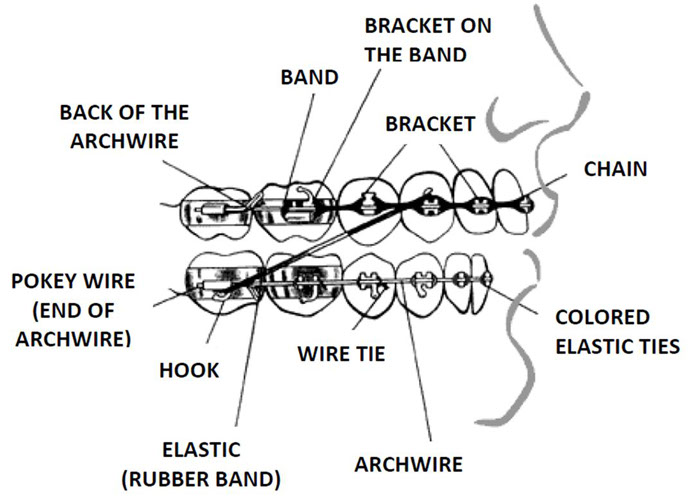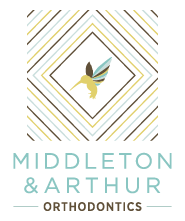Oral Hygiene
Brushing your teeth is even more important when you are wearing braces. Food can get stuck on your braces and cause staining, tooth decay, gum disease, and bad breath. Here are some suggestions on when and how to brush your teeth with braces…
Brush at least four to five times a day following this schedule:
• As soon as you wake up, brush really well (at least four minutes). Plaque has had all night to build up on your teeth. Do this before you get dressed or eat breakfast so you won't be rushed.
• After breakfast, give a quick brush. This is to remove breakfast from your teeth.
• After school, brush really well again. Plaque has been sitting on your teeth since the morning.
• After dinner, another quick brushing.
• Before you go to bed, thoroughly brush with the toothpaste we provide for you and floss.
Flossing while you are wearing braces is more difficult, but well worth it. You will need a floss threader or superfloss in order to floss more easily. We will give you some when you start your treatment and you can purchase them at any drugstore. But remember, the most important step in good oral hygiene with braces is to brush well.
Once you get your braces we will provide you with a lot of information and detailed handouts about your new appliances. Also, you will receive personal instructions on how to keep your teeth clean with braces. If you have any questions, please be sure to ask one of us.
Embrace It!
Our office has partnered with Crest + Oral B on Embrace it! to bring the best oral hygiene products to our patients. Learn more at www.oralb.com/embraceit
Orthodontic Parts


Orthodontic Emergencies
The following outline describes how dental emergencies are handled with patients in orthodontic appliances. Dental emergencies while wearing braces or other orthodontic appliances fall into two categories: 1) Direct injuries to the mouth or teeth or 2) Emergencies to orthodontic appliances.
1) Direct injuries to the mouth or teeth
Following a direct injury to your mouth or teeth, you should be seen by your regular dentist as soon as possible. Usually, a radiograph of the involved tooth, or teeth, is needed to ascertain the extent of injury. If a tooth has been knocked out, severely displaced or fractured, it is best to contact your family dentist first, since we may not have the necessary materials needed to treat these injuries. If the orthodontic appliances are dislodged or displaced, we will need to replace or adjust them as soon as possible.
Please call our office immediately after seeing your family dentist. If you are unable to reach your family dentist or an alternate emergency facility, call this office and we will assist you in locating someone to care for the injury. Please discuss potential emergency procedures with your family dentist at your next visit to their office.
2) Emergencies related to orthodontic appliances
Broken or disturbed appliances are likely to occur from time to time during your orthodontic care. As the teeth begin to move, a wire will sometimes poke out. If there is any disturbance such as loose bands, broken brackets, or pokey wires, please call our office as soon as possible so we can evaluate the urgency of the problem and schedule you to be seen accordingly. Please refer to the section on "foods to avoid" to learn how to prevent or minimize broken appliances.
Loose brackets or bands
Call our office on the next business day for advice if a bracket or wire is loosened. You may have a situation that requires cutting a wire or sliding a bracket off a wire at night or over the weekend. Most of the time, a loose bracket will just slide around on the wire and will not irritate your mouth. If you need to cut a wire in case of emergency, you may use fingernail clippers that have been washed and sterilized in alcohol. Please call our office the next business day, so that we may schedule an appointment for you. We will provide you with wax that can provide relief and protection.
Wire irritations
Sometimes discomfort caused by a wire on your braces can be resolved by moving the wire away from the irritated area with a cotton swab or eraser. If the wire will not move, try covering the end of it with a small piece of cotton or a small amount of wax. If the wire is painful, you can cut it with nail clippers or scissors that have been washed and sterilized in alcohol. If you cannot resolve the wire irritation, call our office for an appointment.
Lost separators
Sometimes patients can lose a separator (rubber blue ring between teeth) during their treatment. Do not worry about losing a separator, but please call our office on the next business day for further instructions and to see if it needs to be replaced.
Discomfort with orthodontic treatment
Initially the braces feel like they “stick out”. This is normal. As you become accustomed to your braces and tooth alignment improves, this sensation will cease to be a concern. Although the brackets have been rounded and smoothed, until the cheek tissues have “toughened,” you may find it helpful to use a small piece of orthodontic wax around the bracket that is creating the irritation. If your supply of wax runs out, call our office for more.
During the first week after your braces are in place and routine adjustments are complete, you will likely feel some pain, soreness or discomfort. You may take ibuprofen or other anti-inflammatory pain relievers while you adjust to your new braces. A warm wash cloth or heating pad may reduce the soreness in your jaws. You can also expect your teeth to feel loose during orthodontic treatment, which is normal.
3) After-hours Emergencies
Should you have an orthodontic emergency after office hours, please call our office at 936-582-7700 and an emergency number will be available for you to call.
Emergency Care - PDF
Orthodontic Food List
There are certain dietary habits that are known to cause breakage of orthodontic appliances as well as increase the risk of dental disease. Our aim is to achieve the treatment goals with as few disturbances due to appliance breakage as possible and to minimize the side effects of poor diet choices. Remember, teeth move best in a healthy environment and in individuals with excellent overall health. Be sure you have a well-balanced diet.
Potential harm to your teeth and gums
Foods and drinks which your dentist has suggested may cause dental caries (cavities) should be restricted while wearing braces. Sticky foods are to be avoided because of the increased risk of dental decay and appliance breakage. These foods stick to braces and remain on your teeth for long periods of time. If foods or drinks high in sugar content are to be consumed, we advise having them with regular meals or at one given time of day. Please make sure that careful brushing and rinsing take place immediately afterwards. Between meal snacks should be confined to foods without refined sugar and should be followed by vigorous rinsing if a toothbrush is not available.
Please keep fingers and pencils away from your brackets. Avoid "picking" at your braces to avoid harm to the appliances.
Potential harm to your braces
Braces are attached to your teeth with an adhesive which normally will withstand the forces of eating. However, braces can be dislodged and wires bent or broken while eating certain foods. Hard foods, such as nuts, hard candy, corn chips and even crisp taco shells, can harm your braces and should be avoided. Chewing ice cubes, pencils and fingernails can also be very destructive to your appliances. Some foods, such as whole apples, raw carrots or celery, are healthy snacks, but must be cut up to avoid damaging your braces.
Chewy foods, such as gum, caramels, and even thick bread crusts, can bend and distort wires causing treatment delays and extra visits for repairs. Popcorn can cause harm in multiple ways. The husks from the popcorn can become lodged beneath the braces and cause irritation to the gum tissue. Un-popped kernels can shear or break off brackets as well as bend or dislodge wires.
If you have any questions about dietary restrictions or good food choices, please ask!
Ortho Food List - PDF


